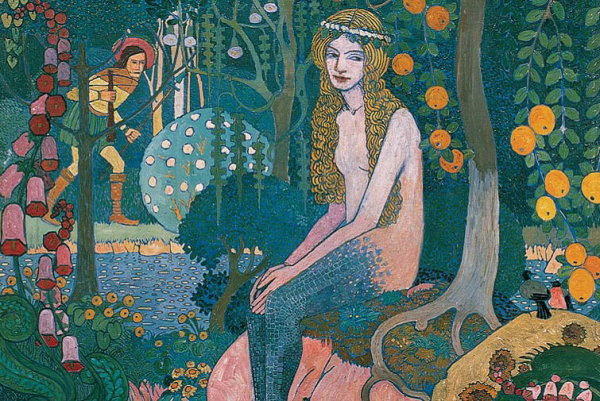Long ago I was often inspired to do crazy research on passing thoughts and ideas. Smelling Books and Chromolithography and the mystery of Henri and Anita LeRoy, on why certain books smell the way they do and who was really the artist behind common chromolithography prints, respectively, are past products of my ardent desires to answer a question. It’s been a long time since I’ve given myself time to fall down that rabbit hole, but I am feeling the inclination once again. I have a list of curiosities I wanted to return to. Melusine is on that list. For better, or worse, I’ve only geared up to capsule research. The ridiculously extensive posts may still come.

The story of Melusine is a fairy tale legend wherein a fairy queen and the king of Scotland had a daughter. Melusine angered her fairy queen mother by imprisoning her father and was cursed to turn into a half-snake beast on Saturdays. Her beast form is often depicted as a two tailed mermaid or something more akin to a naga, a creature from Hindu mythology that has the bottom half of a cobra.
I could not find any more food to feed my passing thought that Melusine is a rogue Naga Kanya, if the Naga Kanya are in fact an entire race of fairy creatures instead of one. I did find that several pinterest boards have noticed the similarity in the two tailed stone depictions of Melusine and those of the fertility goddess Sheela Na Gig. These similarities intrigue me. While poking around in the easily locate-able online sources, I did find that stories of a half serpent, half beautiful woman can be found across Albania, Germany, and France.
In the most well known story from France, Melusine married a nobleman and brought agricultural advances and fortune to the people over which he ruled. But, curiosity became too much for her husband, leading him to break the promise he made to leave her in seclusion on Saturdays. He spied on her, witnessing her changed form. Upon learning of this, Melusine sprouted wings and flew away, never to return (British Library – European Studies Blog).
Most interesting is how, before her husband’s transgression and her disappearance, Melusine bore several sons, making her a founding mother of European nobility. This fairy lineage would eventually be referred to as dragon blood, referencing Melusine’s final winged form. Of course, her split serpent tales has become familiar to many of us as an image of the commercial depiction of Starbuck (Ancient Origins).
